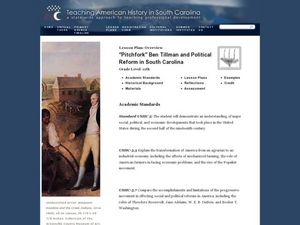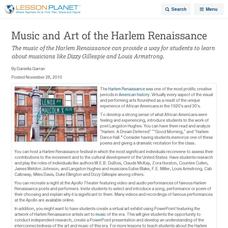Alabama Department of Archives and History
W.E.B. DuBois, Booker T. Washington, and Jim Crow
Class members use the think-pair-share strategy to compare the views of W.E.B. Du Bois and Booker T. Washington and to consider how each man's backgrounds influenced his philosophy.
Alabama Department of Archives and History
Booker T. Washington and W.E.B. DuBois
Where to begin? With the vocational education that provides the skills necessary to gain economic security or with a Liberal Arts education? As part of a study of leaders of the civil rights movement, class members compare and contrast...
Curated OER
Booker T. Washington and W. E. B. DuBois: The Problem of Negro Leadership
Students focus on the problem of African American leadership throughout American history. In groups, they research the life and works of Booker T. Washington and W.E.B. DuBois and how they worked to promote the need for African American...
Alabama Department of Archives and History
Two Different African-American Visions: W.E.B. Du Bois and Booker T. Washington
The strategies civil rights activists Booker T. Washington and W.E.B. Du Bois proposed for blacks to achieve racial progress is the focus of an activity in which class groups identify the strategies as well as the benefits and drawbacks...
Center for History and New Media
Growing Up in a Segregated Society, 1880s–1930s
What did segregation look like in the beginning of the 20th century? Middle and high schoolers view images of segregated areas, read passages by Booker T. Washington and W.E.B. DuBois, and come to conclusions about how the influence of...
Penguin Books
A Teacher's Guide to the Signet Classic Edition of Booker T. Washington's Up from Slavery
Booker T. Washington was often criticized by W.E.B. Dubois and other African American leaders for his conciliatory approach to civil rights and education voiced in his autobiography Up From Slavery. This teacher's guide not only...
Albert Shanker Institute
Strategizing for Freedom
Booker T. Washington, W.E.B. DuBois, Marcus Garvey, and A. Philip Randolph developed different views on how to advance civil rights for African Americans. Class members research these famous figures and their strategies before developing...
Curated OER
Dubois and Washington Venn Diagram
Students compare and contrast the visions of W.E.B. Dubois and Booker T. Washington. In this African American history lesson, students read biographies about both men and create a Venn diagram about the men.
Curated OER
Black America And the War in Vietnam
Students explore Vietnam War from Afrocentric perspective, examine experiences of black people both at home and in war zone, and write three to five page response to quote by W.E.B. DuBois regarding race relations and Vietnam War.
Curated OER
Fighting for Democracy, Fighting for Me
Students consider how African American responded to social injustice. In this social injustice lesson plan, students compare and contrast the visions of Booker T. Washington and W.E.B. DuBois for obtaining civil rights for African...
Curated OER
Marcus Garvey and the Rise of Black Nationalism
Fourth graders explore the differing beliefs of African American activists. In this American history lesson, 4th graders examine the views of racism resistance that Booker T. Washington, W.E.B. DuBois, and Marcus Garvey held.
University of North Carolina
Remembering Martin Luther King, Jr.
After reading the article "Kings Dream Everyday," class members conduct a Socratic seminar discussion of Martin Luther King's contributions to the civil rights movement. They then read and respond to a passage from Michael Eric Dyson's...
Curated OER
African-American Soldiers in World War I: The 92nd and 93rd Divisions
Students research the role played and contributions made by African American soldiers during World War I. They discuss the evolution of civil rights in America's history, and the progress that has been made in the last 100 years.
Curated OER
African-American Soldiers After World War I: Had Race Relations Changed?
Students utilize an online database to conduct research and analyze the conditions for African-Americans before and after World War I. They consider the role of the 92nd and 93rd divisions in affecting social change.
Center for History and New Media
The Daily Experience of the Laurel Grove School, 1925
What was daily life like for those attending segregated schools in 1925? Modern learners fill out a KWHL chart as they explore historical background and primary source documents about the Laurel Grove School in Fairfax County, Virginia....
Curated OER
US Civil Rights Movement: Beginnings through the 60s
A real find for a U.S. History teacher, this presentation could supplement many class sessions about the Civil Rights Movement. Pictures of events, major figures, and "Whites Only" signs are striking and effective for even your most...
Library of Congress
The Harlem Renaissance
The Harlem Renaissance brought forth many American art forms including jazz, and the writings of Zora Neale Hurston and Langston Hughes. Using a carefully curated set of documents from the Library of Congress, pupils see the cultural...
Curated OER
Clash of Cultures: Comparing the 1920s and 1960s
Students compare the social, cltural and politicalp roblems of the 1920s with the 1960s.
Curated OER
Clash of Cultures: Comparing the 1920s and 1960s
Students identify the social, culturaland political problems of the 1920s and compare them to the problems of the 1960s. They research both eras and then make a presentation to the rest of the class.
Curated OER
The Rise of Segregation
Eleventh graders describe the foundation for legal segregation in the South and identify three key African American leaders' responses to discrimination. They also find and copy the definition of sharecropper and answer a variety of...
Curated OER
"Pitchfork" Ben Tillman and Political Reform in South Carolina
Eleventh graders examine the political reform movement in South Carolina spearheaded by "Pitchfork" Ben Tillman. In this South Carolina history lesson, 11th graders examine primary and secondary sources regarding Tillman and his vision....
Curated OER
Music and Art of the Harlem Renaissance
The music of the Harlem Renaissance can provide a way for students to learn about musicians like Dizzy Gillespie and Louis Armstrong.
Curated OER
Harlem Renaissance
Students investigate the African American culture in the 1920's and the Harlem Renaissance. They read and analyze poems written by poets of the Harlem Renaissance, listen to jazz music and identify the characteristics of the music, and...
Curated OER
John Gary Evans and the Politics of Race
Students read letters written by Evans and Gunton regarding race relations. In this Progressive Movement lesson, students interpret the intentions and tone of the letters to understand contemporary racial beliefs. Students discuss the...

























